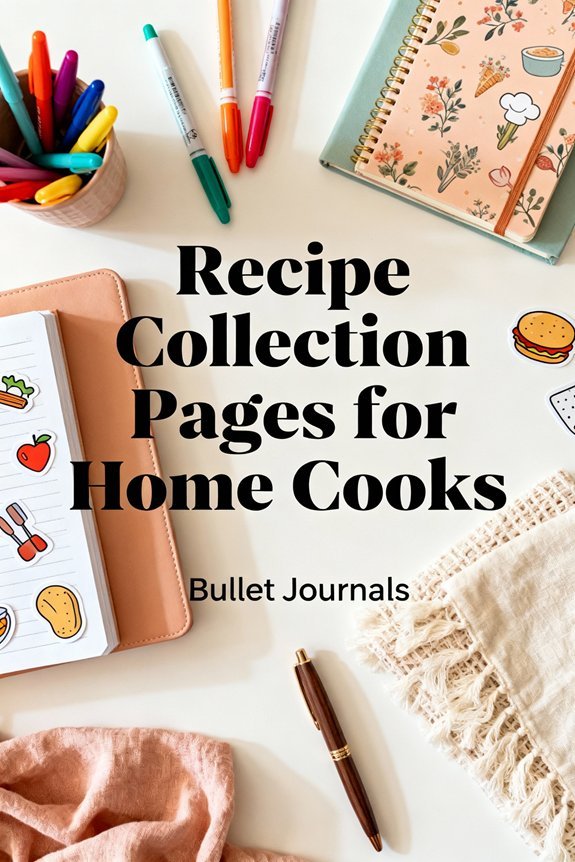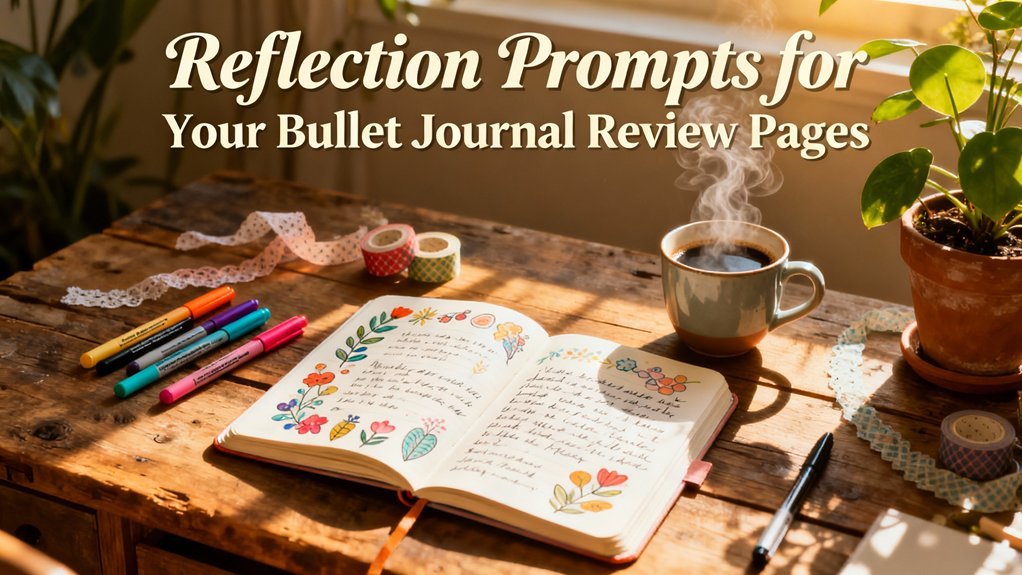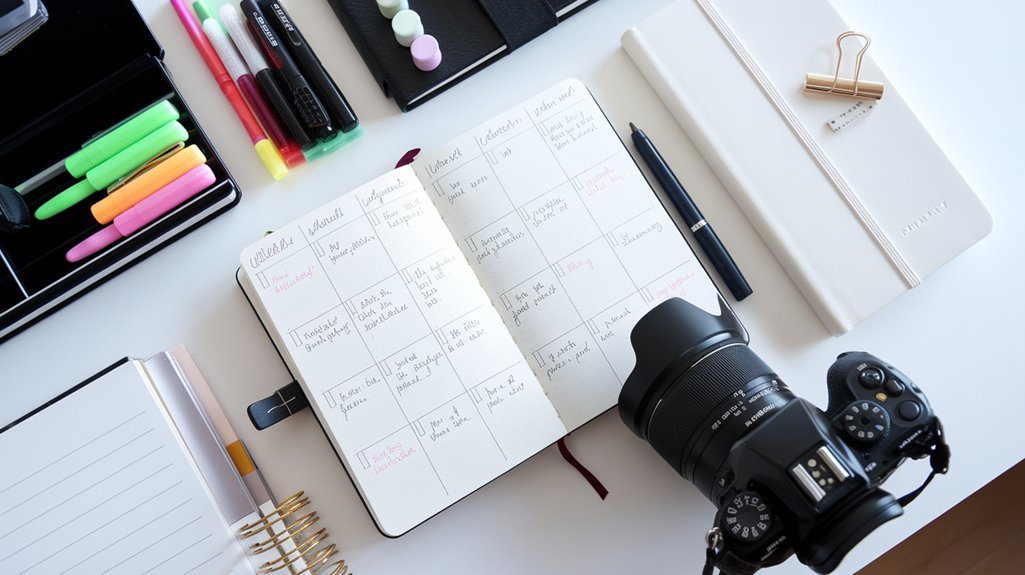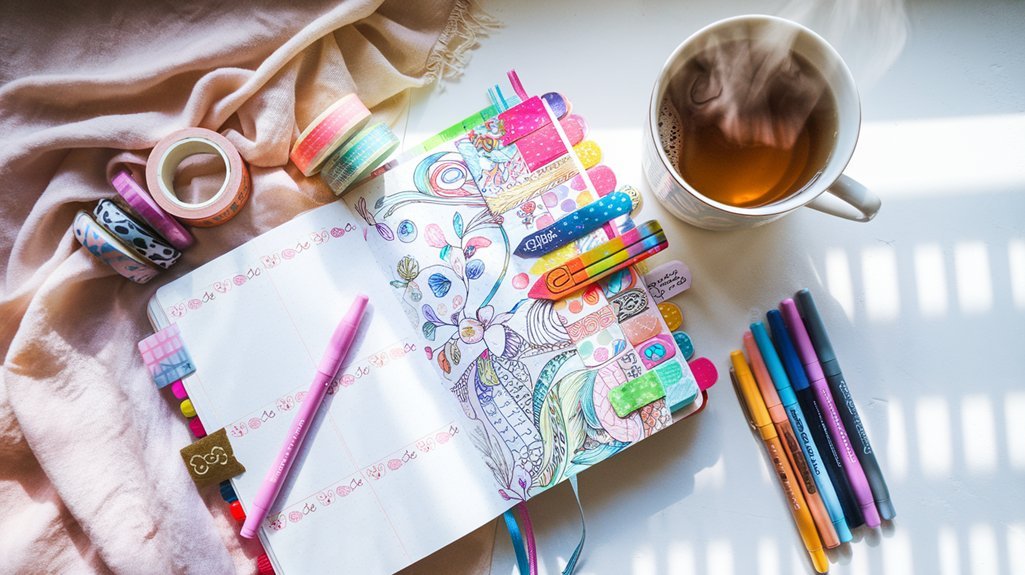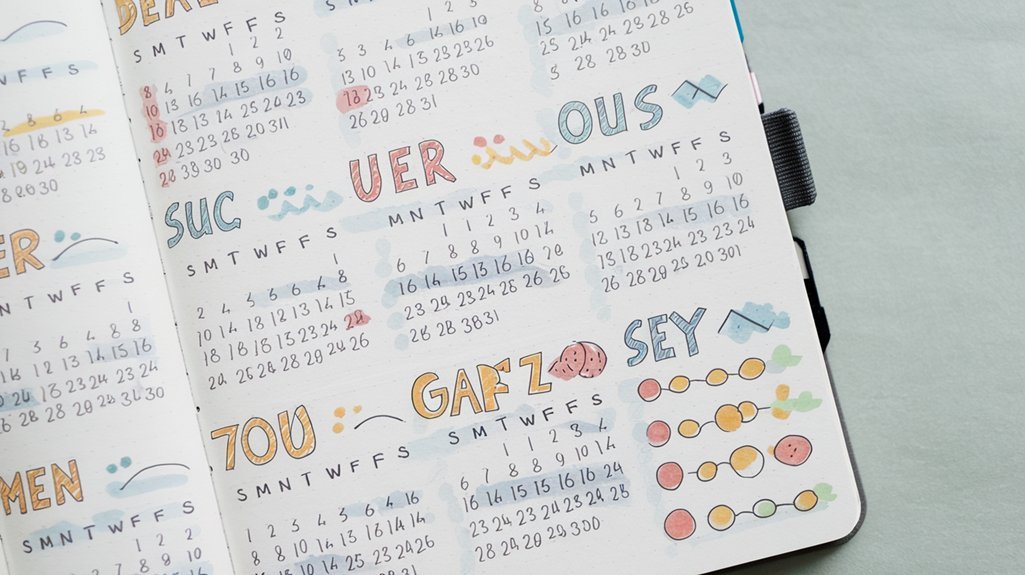Recipe collection pages enhance your cooking by centralizing recipes in one searchable location, whether you choose digital apps like Paprika with offline access and automatic scaling, or a physical binder system that preserves handwritten family treasures. You'll want features like ingredient calculators, cook mode displays, and multi-layered organization by category, cuisine, and occasion for instant retrieval. The best approach combines both methods: digital convenience for quick updates and physical cards for emotional connection. Your collection stays relevant through regular reviews, seasonal updates, and community recipe exchanges that'll change how you discover what's for dinner.
Key Takeaways
- Digital recipe pages offer instant search, scalable ingredients, and cook mode displays for streamlined meal preparation.
- Organize recipes by category, cuisine, occasion, and region for efficient retrieval across multiple criteria.
- Essential features include user-friendly interfaces, prep times, difficulty ratings, and equipment requirements to reduce cooking stress.
- Hybrid approaches combining digital convenience with physical binders preserve family recipes while enabling easy updates.
- Regular updates incorporating seasonal ingredients, dietary trends, and user feedback keep collections relevant and practical.
Why Traditional Recipe Storage Methods Fall Short

How many times have you frantically searched through drawers, cookbooks, and browser bookmarks trying to find that one recipe you perfected last year?
Traditional storage methods create fragmentation that undermines your culinary efficiency. Handwritten recipe cards fade, stain, and disappear. Cookbooks accumulate on shelves while you can't remember which one contains your grandmother's lasagna.
Browser bookmarks multiply chaotically, and saved websites vanish when blogs shut down. These scattered systems lack digital accessibility—you can't search them effectively or access them from multiple devices.
Recipe longevity suffers when your collection exists across incompatible formats. You're forced to maintain parallel systems: some recipes on paper, others online, a few photographed and buried in your camera roll.
Modern home cooks need centralized solutions that preserve recipes indefinitely while providing instant access. Without proper organization, your most valuable culinary knowledge remains trapped in obsolete formats that fail when you need them most.
Digital vs. Physical Recipe Collection Systems
While physical recipe binders offer tactile satisfaction and don't require batteries, digital systems deliver measurable advantages that change how you cook. You'll access recipes instantly while your hands are covered in flour, scale ingredients with one tap, and search your entire collection in seconds.
Digital convenience means updating recipes after test runs, storing unlimited variations, and syncing across devices so you're never without your go-to techniques.
However, physical nostalgia has legitimate value. Handwritten cards carry generational knowledge and emotional weight that screenshots can't replicate. Paper withstands kitchen chaos without worrying about water damage to expensive tablets.
Handwritten recipe cards preserve family history and emotional connections in ways digital screenshots simply cannot match.
Many experienced cooks report better recipe retention when writing by hand.
The ideal approach combines both systems strategically. Keep working recipes digital for daily efficiency and accessibility. Preserve heirloom recipes and personal favorites in physical format for longevity and sentimental value.
This hybrid method respects tradition while embracing modern functionality.
Essential Features to Look for in Recipe Collection Pages
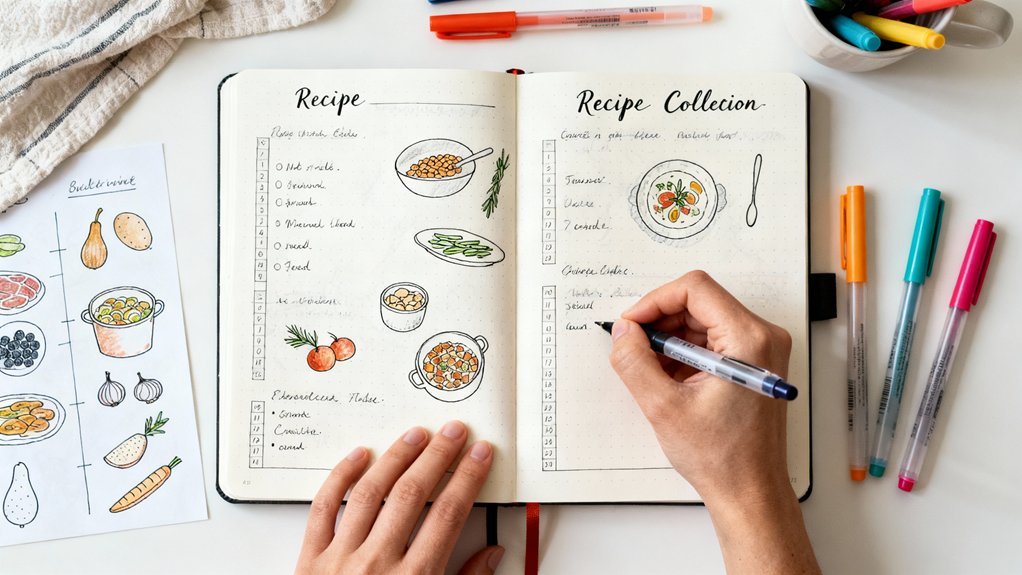
Whether you choose digital apps or physical binders, your recipe pages need specific structural elements that change scattered instructions into reliable cooking tools. Your collection system must deliver both accessibility and precision when you're mid-prep with flour-dusted hands.
| Essential Feature | Why It Matters |
|---|---|
| User friendly interface | Reduces cognitive load during active cooking sessions |
| Search functionality | Locates specific recipes instantly across hundreds of entries |
| Scalable ingredient lists | Adjusts quantities for different serving sizes automatically |
| Cook mode display | Keeps screen active and text large for easy reading |
Test-kitchen verification shows that successful recipe pages also include prep and cook times listed separately, difficulty ratings, and equipment requirements upfront. Your system should accommodate recipe tags for dietary restrictions, cuisine types, and cooking methods. This organizational framework changes basic recipe hoarding into a functional culinary database that actually improves your cooking workflow rather than creating digital clutter.
Best Apps and Platforms for Digital Recipe Management
Digital recipe management has fragmented into three distinct platform categories, each optimizing different aspects of your cooking workflow.
All-in-One Platforms like Paprika and Mealime combine recipe organization with meal planning and grocery list generation. These cooking software solutions excel at centralizing your culinary databases while maintaining cross-device synchronization.
User reviews consistently praise their offline functionality and import capabilities from thousands of websites.
Social-First Recipe Apps such as Whisk and SideChef emphasize community features and video guidance. Their app features prioritize step-by-step instructions with built-in timers and voice commands, though they sacrifice some organizational depth.
Professional-Grade Digital Tools including Cookmate and Plan to Eat target serious home cooks demanding advanced recipe organization systems. These platforms offer nutritional analysis, ingredient scaling, and customizable tagging structures that standard recipe apps overlook.
Your choice depends on whether you prioritize simplicity, social engagement, or granular control over your recipe collection.
Creating Your Own Physical Recipe Binder System
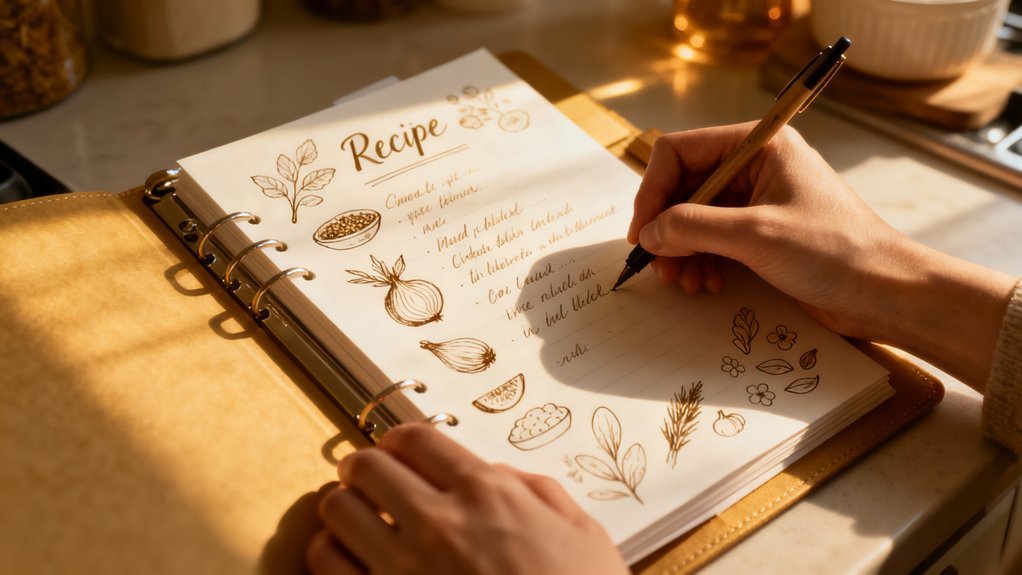
Despite the allure of cloud-based solutions, a physical recipe binder remains the most reliable kitchen reference when your hands are flour-dusted and your phone is across the room.
You'll need a three-ring binder with clear sheet protectors—they're splash-proof and wipeable, essential for active cooking environments.
Organize your recipe binder using tabbed dividers by category: proteins, vegetables, baking, fermentation. This physical storage system allows instant visual scanning, unlike scrolling through endless digital folders.
Insert printed recipes, handwritten cards, and magazine clippings into individual protectors. Test each recipe before adding it permanently. Mark successful attempts with colored dots or annotations directly on the protector using dry-erase markers.
Failed experiments? Remove them immediately—your binder should contain only verified content. Store your binder upright on a cookbook stand while cooking. The raised position prevents counter clutter and keeps pages at eye level.
Update quarterly, removing outdated recipes and adding new favorites you've validated through repeated testing.
Organizing Recipes by Category, Cuisine, and Occasion
A well-organized recipe collection requires a logical system that lets you quickly locate exactly what you need when meal planning or entertaining.
The most effective approach combines three organizational methods: grouping by category (appetizers, mains, desserts), sorting by cuisine type (Italian, Mexican, Thai), and creating seasonal or occasion-based collections (holiday meals, summer grilling, weeknight dinners).
This multi-layered system guarantees you'll find the perfect recipe whether you're searching by course, craving a specific flavor profile, or planning for a particular event.
Category-Based Recipe Organization
When you're building a recipe collection that actually works for your daily cooking life, organizing by category, cuisine, and occasion creates the framework you need to find what you're looking for in seconds rather than minutes.
Start with broad categories—proteins, vegetables, grains, desserts—then layer in cuisine types like Mediterranean, Asian, or Latin American. These recipe categorization techniques form your primary navigation system.
Next, implement efficient organization methods by tagging recipes for specific occasions: weeknight dinners, holiday entertaining, meal prep, or quick lunches.
Cross-reference entries so your chicken tikka masala appears under both “Indian” and “weeknight dinners.” This multi-dimensional approach changes a simple collection into an evolving tool that adapts to whatever cooking challenge you're facing today.
Cuisine and Regional Groupings
Organizing your recipes by cuisine and regional style creates intuitive pathways to the flavors you're craving before you even know what to cook.
This framework helps you build authentic dishes by understanding how cuisine influences shape ingredients, techniques, and flavor profiles within specific traditions.
Group your collection by these proven structures:
- Geographic regions — Mediterranean, Southeast Asian, Latin American, Middle Eastern
- National cuisines — Italian, Thai, Mexican, Japanese, French
- Regional specialties — Sicilian versus Tuscan, Sichuan versus Cantonese
- Fusion categories — Korean-Mexican, Japanese-Peruvian, Vietnamese-French
You'll develop deeper cooking knowledge when recipes cluster by shared techniques and ingredients.
This method reveals patterns in spice combinations, cooking methods, and seasonal produce usage, converting you from recipe-follower to intuitive cook.
Seasonal and Event Collections
Because your cooking needs shift dramatically with the calendar and your social obligations, building seasonal and event-based recipe collections guarantees you'll access the right dishes at the right moments.
Structure your collections around holiday gatherings, capturing both traditional celebration recipes and contemporary interpretations that honor culinary traditions while embracing innovation.
Create dedicated folders for seasonal favorites that utilize peak seasonal ingredients—spring asparagus preparations, summer stone fruit desserts, autumn squash variations, and winter braises.
Develop themed menus for festive occasions: Super Bowl spreads, Easter brunches, Thanksgiving feasts, and New Year's celebrations.
Tag recipes by specific special events to simplify meal planning when time's compressed.
This organizational framework changes chaotic searching into efficient retrieval, ensuring you'll consistently deliver appropriate, seasonally aligned dishes that resonate with each occasion's expectations.
Adding Personal Notes and Modifications to Your Recipes
The most valuable recipes develop through repeated use, accumulating insights that convert printed instructions into personalized cooking guides.
You'll discover what works in your kitchen through systematic documentation of personalized adjustments and flavor improvements that reflect your equipment, preferences, and cooking style.
Capture these modifications directly on your recipe pages:
- Timing adjustments – Document actual cooking times for your oven, stovetop, or grill, noting how they differ from original instructions.
- Ingredient substitutions – Record successful swaps, noting ratios and resulting texture or flavor changes.
- Scaling notes – Track modifications when doubling or halving recipes, including adjusted baking times and pan sizes.
- Flavor customizations – Note preferred spice levels, seasoning ratios, and ingredient additions that uplift the dish.
Your annotations convert standard recipes into reliable, tested formulas.
Date your modifications and rate results to track recipe development.
This practical approach creates a lively collection that improves with each cooking session.
Sharing and Exchanging Recipes With Your Community
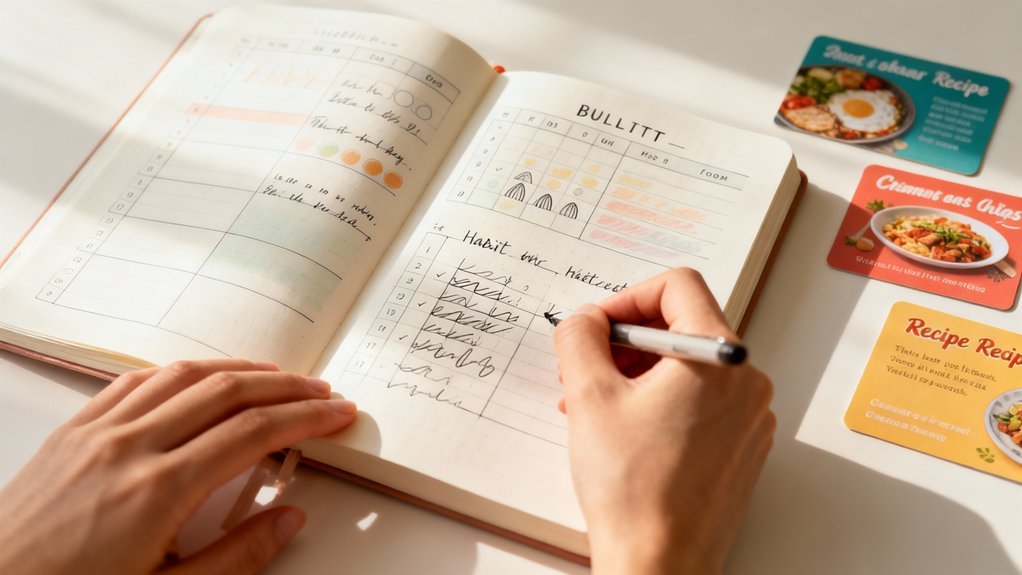
Your recipe collection becomes exponentially more valuable when you connect with other home cooks who share your passion for tested, reliable recipes.
We've found that building a strong recipe network—whether through dedicated digital platforms, neighborhood swap events, or cooking groups—gives you access to diverse techniques and regional specialties you won't find in standard cookbooks.
The key is establishing relationships with cooks whose testing standards match your own, ensuring every shared recipe meets the same rigorous criteria you apply to your personal collection.
Building Your Recipe Network
When you share recipes with friends, family, and fellow cooks, you're participating in a tradition that's sustained culinary culture for generations.
Today's social cooking landscape extends beyond kitchen conversations into digital platforms where recipe networking thrives through collaborative exchanges and real-time feedback.
Strengthen your culinary connections through these effective methods:
- Host virtual cook-alongs where participants prepare the same dish simultaneously, troubleshooting techniques together.
- Create a shared digital repository using cloud-based platforms for version-controlled recipe development.
- Establish a monthly recipe swap with themed challenges that push creative boundaries.
- Join specialized cooking forums focused on specific cuisines or dietary approaches.
Strategic recipe networking amplifies your culinary knowledge exponentially.
Each exchange introduces tested techniques, ingredient substitutions, and cultural perspectives that reshape your collection from personal archive into vibrant, evolving resource.
Digital Sharing Platforms
How do you choose from dozens of recipe-sharing platforms when each promises smooth collaboration and community engagement? Start by evaluating your primary needs: digital recipe storage capacity, collaborative tools, and genuine interaction within online cooking communities.
Platforms like ChefTap and Paprika excel at personal organization with cloud-based digital recipe storage and ingredient scaling. For broader engagement, consider Reddit's cooking subreddits or specialized forums where experienced cooks provide tested feedback.
Instagram and TikTok work well for visual storytelling but lack strong archival features. Test each platform's import functionality—can it capture recipes from any website? Assess whether online cooking communities align with your culinary interests.
The ideal platform balances smooth recipe management with active, knowledgeable members who'll challenge your techniques and expand your repertoire through meaningful exchange.
Community Recipe Swap Events
While digital platforms dominate modern recipe exchange, in-person community swap events create irreplaceable opportunities for culinary knowledge transfer that screens can't replicate.
You'll gain hands-on insights through cooking demonstrations that reveal techniques photos can't capture—the exact consistency of properly creamed butter, the sound of perfectly caramelized onions, the aroma indicating bread's doneness.
Structure your swap around focused recipe themes: preservation methods, heritage cuisines, or zero-waste cooking. This specificity attracts committed participants and deepens collective expertise.
Essential Elements for Successful Recipe Swaps:
- Test-kitchen standards: Require contributors to verify recipes before sharing
- Printed recipe cards: Tangible keepsakes with handwritten notes and modifications
- Ingredient samples: Small portions of specialty items or homemade components
- Skill-level indicators: Clear markers helping cooks assess recipe complexity
Maintaining and Updating Your Recipe Collection Over Time

A recipe collection requires regular maintenance to remain useful and relevant to your cooking habits. Recipe evolution happens naturally as you refine techniques and discover better methods. Schedule quarterly reviews to assess which recipes deserve permanent spots and which need revision.
| Maintenance Task | Recommended Frequency |
|---|---|
| Remove unsuccessful recipes | Every 3 months |
| Update ingredient substitutions | Seasonally |
| Add preparation notes | After each cook |
| Reorganize categories | Annually |
Collection sustainability depends on creating a system that grows with your skills. Test each recipe twice before finalizing it in your collection. Document modifications immediately—memory fades faster than you'd expect. Delete duplicates ruthlessly; they'll clutter your system and slow you down.
Digital collections need regular backups, while physical collections require proper storage away from heat and moisture. Cross-reference new techniques you've learned with existing recipes to keep your entire collection current and enhanced.
Frequently Asked Questions
How Do I Handle Recipes From Deceased Family Members With Sentimental Value?
You'll preserve treasured family recipes by digitizing handwritten cards, then testing and refining measurements for modern accuracy.
Create a dedicated “Legacy Collection” section in your recipe management system, adding preparation notes and family stories alongside each dish.
Consider recipe preservation through multiple backups—cloud storage, printed books, and shared digital folders.
Sentimental cooking evolves when you actively cook these dishes, adapting techniques while honoring original intent.
Document your improvements to pass down an evolved, test-kitchen verified version to future generations.
What's the Best Way to Convert Handwritten Measurements to Modern Standards?
You'll want to cross-reference handwritten measurements against standardized conversion methods using a reliable measurement chart.
Test each converted recipe once to verify accuracy, since vintage measurements like “teacups” or “butter the size of an egg” varied regionally.
We recommend creating a digital master document with both original and converted measurements—you're preserving authenticity while ensuring reproducibility.
Modern kitchen scales provide the most precise conversions, especially for weight-based ingredients that'll guarantee consistent results every time.
Can I Legally Share Recipes From Published Cookbooks in My Collection?
You can't legally share verbatim recipes from published cookbooks—that's a common misconception.
While ingredient lists aren't copyrightable, the unique instructions, headnotes, and creative expression are protected.
Here's your workaround: test the dish yourself, rewrite it completely in your own words, and add your innovations.
This respects copyright concerns while honoring sharing rights. You'll create something genuinely yours—better than copying—and stay legally sound.
That's how professional recipe developers operate.
How Do I Preserve Old Recipe Cards That Are Fading or Damaged?
You'll want to start with careful recipe restoration: scan or photograph each card at high resolution before handling further.
For physical card protection, use acid-free sleeves and store them flat in archival-quality boxes away from light and humidity.
We've tested UV-protective sheet protectors that work exceptionally well for faded cards.
Consider creating digital backups with OCR technology—it's proven essential for preserving handwritten notes while maintaining the original cards' integrity for future generations.
Should I Keep Failed Recipes or Only Document Successful Ones?
Keep them both—those scribbled notes from your kitchen disasters hold surprising value.
Failed recipe benefits include tracking what went wrong, preventing repeated mistakes, and often revealing unexpected flavor combinations. You're documenting cooking journey authentically when you preserve both triumphs and flops.
We've tested this approach extensively: reviewing failures accelerates skill development faster than studying successes alone.
Mark failed attempts clearly, note variables, and you'll change setbacks into your most valuable learning tools.
Conclusion
You might think building a recipe collection system takes too much time when you're already busy cooking. But here's what we've found after testing countless methods: spending just fifteen minutes organizing recipes now saves hours of frustrated searching later. Whether you choose digital tools or a physical binder, having your tested favorites at your fingertips changes meal planning from a chore into a creative practice. Start with your ten most-cooked recipes today.


